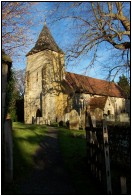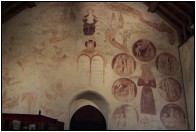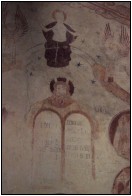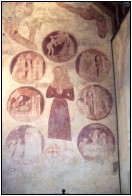| |
 
TREASURES AT
TROTTON
 |
|
The Church of St.
George at Trotton is well known to lovers
of old churches, for within its rather
barn-like walls are great treasures.
Apart from the tower, which is earlier,
it dates from about 1300, and was built
thanks to the generosity of one of
England’s great families, the
Camoys, who held the manor for more than
two centuries. Their tombs remain: a
beautiful brass to Lady Margaret, who
died in 1310 and the magnificent table
tomb of Lord Thomas Camoys, hero of
Agincourt, and his wife Elizabeth, in
front of the altar.
The west wall of the church is part of a
picture book, such as all church walls
were before the Reformation. King Henry
VIII and his successor, the boy king
Edward VI ordered that all painted images
and sculptures should be destroyed or
painted over, and so they were hidden
from view until they were accidentally
discovered in 1904. |
The painting, carried out
in simple earth colours, depicts a simplified
version of the last Judgement, or Doom. Christ
sits on a double rainbow at the top, whilst two
angels bring two souls, one blessed and one
cursed, into his presence. Below sits Moses, with
the tables of the Law.
On our left, below the cursed soul, is the 9 ft.
high figure of Satan, nude and full frontal,
surrounded by the Seven Deadly Sins: Pride,
Gluttony, Avarice, Wrath, Lust, Sloth and Envy.
The best preserved is Gluttony, drinking from a
large jug, with an empty flagon beside him.
| Many years ago I
was told the story, probably apocryphal,
of how these paintings were discovered.
News that something was hidden under the
limewash had been made known, and one
Sunday afternoon the Vicar’s
daughter took her trowel and decided to
investigate further. Of course, so the story
went, she uncovered the very part of the
nude figure that no young lady, let alone
a Vicar’s daughter at the start of
the last century, should have seen, and
it caused great scandal, leading to the
vital parts being obliterated. And so
they remain to this day.
|
|
 |
Corresponding with the
figure of Satan on the other side, and below the
blessed soul, is a modestly clad man with long
hair and a beard, in an attitude of prayer, the
equivalent of Good Deeds in the Morality Play,
Everyman. He is supported by scrolls bearing the
names of the Cardinal Virtues: Fides, Spes and
Caritas (Faith, Hope and Charity.) Surrounding
him are seven medallions containing the Seven
Works of Mercy, all excellently preserved:
Clothing the Naked, Feeding the Hungry, Giving
Drink to the Thirsty, Harbouring the Stranger,
Visiting the Sick, Visiting the Imprisoned and
Burying the Dead.
Particularly
interesting are two on the left of the
figure, as we look at it. In Feeding the
Hungry a woman stands in the doorway of a
multi-gabled building offering sustenance
to two callers, whilst immediately below
a woman bends over a man in bed, holding
his left wrist, whilst another figure
stands at the head of the bed.
It is rare to find this subject painted
on the west wall of a church, although
there is another at Chaldon, in Surrey,
and one can easily imagine its powerful
effect on our mediaeval forbears. Making
their way home after their devotions, it
would have been impossible to leave the
church without confronting its moral
lessons. |
|
 |
|
 |
Tom Muckley, May 2006
This article was originally
published by the
Petersfield Post
tommuckley.co.uk
|
|





